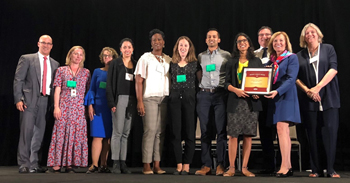St. Michael’s Family Health Team wins award for unique approach to patient engagement

By Danielle Pereira

Members of the Academic Family Health Team, pictured with Ontario Health Minister Christine Elliott, receiving their Bright Lights Award.
Creating the best care experiences means considering all elements of a patient’s time in our care and working together with them to understand and improve the quality of the care they receive.
St. Michael’s Hospital’s Academic Family Health Team was recently honoured by the Association of Family Health Teams of Ontario for doing just that.
The team received a Bright Lights Award in Patient and Family-Centred Care for their engagement work with a representative group of patient advisors to identify and prioritize areas for improvement for a typical medical visit.
We spoke with Dr. Tara Kiran, family physician and Fidani Chair in Improvement and Innovation at the University of Toronto; Linda Jackson, senior clinical program director for Primary and Community Care; and Jacqueline Chen, clinical leader manager with the Academic Family Health Team, about the award and the work the team has done to engage patients.
Can you describe the approach the team took to engaging primary care patients?
TK: We put up posters in our waiting rooms and sent an email to 10,000 patients inviting them to volunteer to spend a Saturday with us to improve the typical medical visit. We were blown away when 350 people volunteered their time. Respondents indicated their interest via an online survey and included information on their age, gender, housing status, and self-reported health. We used that information to randomly select 36 patients to attend the engagement day, ensuring we had a varied demographic that reflected our practice.
We started the event by helping patients become healthcare insiders. We educated them about the healthcare system and how our team operated. We then asked them to work in small groups to identify pain points and then develop recommendations for how we could do better. They gave us a lot of concrete feedback, like how we could improve our waiting room. They also highlighted areas that weren’t on our radar, like better understanding the role of the resident physician. It was clear many patients were there because they were grateful for the good care they received and wanted to give back to help us improve.
What made this a unique approach to patient engagement?
TK: When people think about engaging patients and families in health care, often they jump to forming a patient and family advisory committee. But forming a committee can be a daunting place to start because of the long-term commitment it requires. A committee is also usually limited in the number of people it can include and often the format is more accessible to patients and family members with more time.
The approach we took is a great way for organizations to start on their engagement journey. It doesn’t require a commitment to meet on an ongoing basis. It is also designed to maximize the diversity of voices at the table.
What were some of the outcomes from the event?
LJ: It’s been almost three years since the engagement day and we’re proud to say we’ve made our way through most of the recommendations that came out of that activity.
Gender neutral bathrooms, better use of the waiting room TVs, email appointment bookings, MyChart system so patients can review charts, and streamlined after-hours phone access are just a few of the changes.
But I think the best outcome is that we’ve really developed a culture within our team of patient engagement. We now have a patient advisory council for the family health team, we include patients on our committees and on some hiring panels. We’ve developed a culture where we believe that you can’t do quality improvement without actually having patients involved and verifying what’s important from their lens.
How does engaging patients help with improving the work of the family health team?
JC: We need to understand what matters most to our patients in order to create a patient experience that is meaningful. Our work in engaging patients helps us target specific barriers in our service delivery – whether big or small – that impact health.
LJ: I think it speaks to Unity Health Toronto’s vision – The best care experiences. Created together. Our patient advisors are really generous in wanting to give back but they also want to have a really meaningful role and be involved in the beginning of the planning. They want to know what happens with their feedback.
For our team that really does translate to making changes with our patients, evaluating the experiences with our patients, and having the voice of our patients infused in everything we do.
About St. Michael’s Hospital
St. Michael’s Hospital provides compassionate care to all who enter its doors. The hospital also provides outstanding medical education to future health care professionals in more than 27 academic disciplines. Critical care and trauma, heart disease, neurosurgery, diabetes, cancer care, care of the homeless and global health are among the Hospital’s recognized areas of expertise. Through the Keenan Research Centre and the Li Ka Shing International Healthcare Education Centre, which make up the Li Ka Shing Knowledge Institute, research and education at St. Michael’s Hospital are recognized and make an impact around the world. Founded in 1892, the hospital is fully affiliated with the University of Toronto.
About Unity Health Toronto
Unity Health Toronto, comprised of Providence Healthcare, St. Joseph’s Health Centre and St. Michael’s Hospital, works to advance the health of everyone in our urban communities and beyond. Our health network serves patients, residents and clients across the full spectrum of care, spanning primary care, secondary community care, tertiary and quaternary care services to post-acute through rehabilitation, palliative care and long-term care, while investing in world-class research and education. For more information, visit www.unityhealth.to.
